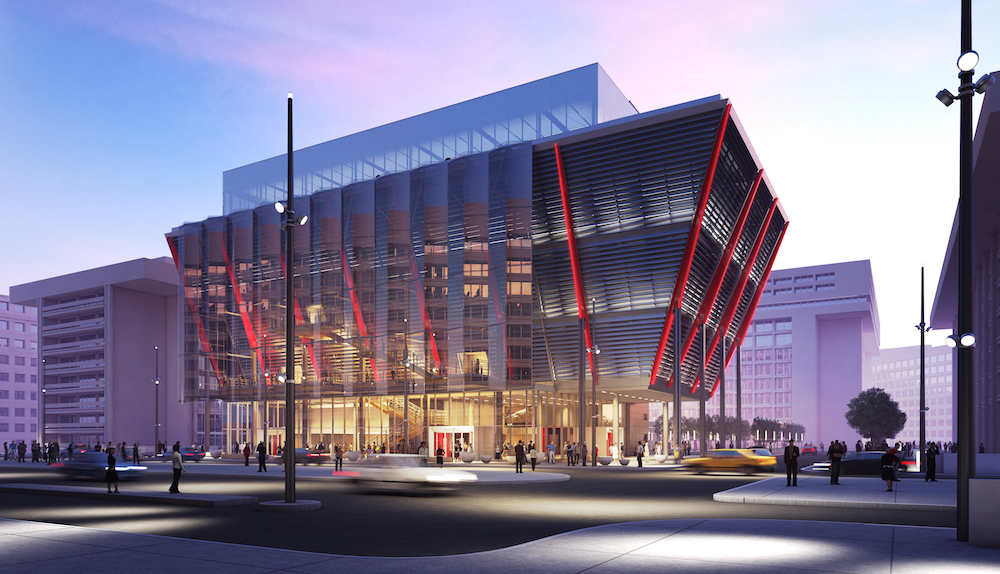The International Spy Museum in Washington, D.C., will be moving next year. If you want the new location of the museum you'll have to travel to a park in Partridge, Kan., where a package awaits you in a hollowed-out tree.
Just kidding! The museum says that it will relocate to a different spot in D.C., at L’Enfant Plaza between the National Mall and the Southwest Waterfront’s Wharf.
Construction has begun on the new 140,000-sf building. Designed by Washington, D.C.’s Hickok Cole Architects and London’s Rogers Stirk Harbour + Partners, the museum will have a glass veil wall in front of an enclosed black-box exhibition space, a setup that contributes to the museum’s “hiding in plain sight” theme.
The glass allows people to see activity inside and outside the museum, which the museum says will add energy to the L'Enfant Plaza. Considered a masterpiece when it opened, the plaza, which sits between a handful of commercial buildings with a shopping mall underneath, has been involved in renovation and demolition plans for years.
The building will have a theater and event spaces, and it will have more exhibition and educational spaces than its current location a few blocks north of the National Mall.
Opened in 2002, the International Spy Museum (SPY) contains exhibits that detail how spies recruit and train, make and break codes, and create false identities. Galleries of artifacts, photos, and videos show the history of espionage from Biblical times through the Cold War to today. The most popular special exhibit is Exquisitely Evil: 50 Years of Bond Villains, where visitors learn about the bad guys in the James Bond film series and how the franchise’s plots have adapted to changes in real-life spying.
The new museum will open in 2018 (Curbed Washington reports that the current museum’s lease doesn’t expire until the end of next year). The project’s developers are The Malrite Company and JBG Companies.
Related Stories
| Sep 12, 2011
Living Buildings: Are AEC Firms up to the Challenge?
Modular Architecture > You’ve done a LEED Gold or two, maybe even a LEED Platinum. But are you and your firm ready to take on the Living Building Challenge? Think twice before you say yes.
| Apr 13, 2011
Expanded Museum of the Moving Image provides a treat for the eyes
The expansion and renovation of the Museum of the Moving Image in the Astoria section of Queens, N.Y., involved a complete redesign of its first floor and the construction of a three-story 47,000-sf addition.
| Apr 12, 2011
Entrance pavilion adds subtle style to Natural History Museum of Los Angeles
A $13 million gift from the Otis Booth Foundation is funding a new entrance pavilion at the Natural History Museum of Los Angeles County. CO Architects, Los Angeles, is designing the frameless structure with an energy-efficient curtain wall, vertical suspension rods, and horizontal knife plates to make it as transparent as possible.
| Jan 21, 2011
Sustainable history center exhibits Fort Ticonderoga’s storied past
Fort Ticonderoga, in Ticonderoga, N.Y., along Lake Champlain, dates to 1755 and was the site of battles in the French and Indian War and the American Revolution. The new $20.8 million, 15,000-sf Deborah Clarke Mars Education Center pays homage to the French magasin du Roi (the King’s warehouse) at the fort.
| Jan 19, 2011
Industrial history museum gets new home in steel plant
The National Museum of Industrial History recently renovated the exterior of a 1913 steel plant in Bethlehem, Pa., to house its new 40,000-sf exhibition space. The museum chose VOA Associates, which is headquartered in Chicago, to complete the design for the exhibit’s interior. The exhibit, which has views of five historic blast furnaces, will feature artifacts from the Smithsonian Institution to illustrate early industrial America.
| Jan 19, 2011
Museum design integrates Greek history and architecture
Construction is under way in Chicago on the National Hellenic Museum, the nation’s first museum devoted to Greek history and culture. RTKL designed the 40,000-sf limestone and glass building to include such historic references as the covered walkway of classical architecture and the natural wood accents of Byzantine monasteries. The museum will include a research library and oral history center, plus a 3,600-sf rooftop terrace featuring three gardens. The project seeks LEED Silver.
| Nov 23, 2010
The George W. Bush Presidential Center, which will house the former president’s library
The George W. Bush Presidential Center, which will house the former president’s library and museum, plus the Bush Institute, is aiming for LEED Platinum. The 226,565-sf center, located at Southern Methodist University, in Dallas, was designed by architect Robert A.M. Stern and landscape architect Michael Van Valkenburgh.
| Nov 2, 2010
Cypress Siding Helps Nature Center Look its Part
The Trinity River Audubon Center, which sits within a 6,000-acre forest just outside Dallas, utilizes sustainable materials that help the $12.5 million nature center fit its wooded setting and put it on a path to earning LEED Gold.
| Oct 13, 2010
Tower commemorates Lewis & Clark’s historic expedition
The $4.8 million Lewis and Clark Confluence Tower in Hartford, Ill., commemorates explorers Meriwether Lewis and William Clark at the point where their trek to the Pacific Ocean began—the confluence of the Mississippi and Missouri Rivers.
| Oct 12, 2010
Gartner Auditorium, Cleveland Museum of Art
27th Annual Reconstruction Awards—Silver Award. Gartner Auditorium was originally designed by Marcel Breuer and completed, in 1971, as part of his Education Wing at the Cleveland Museum of Art. Despite that lofty provenance, the Gartner was never a perfect music venue.
















